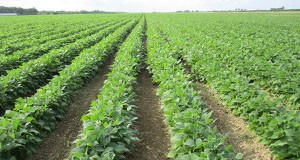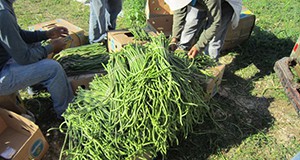 Food diversity, nutritional food supply, and profitability are the priorities of agricultural and horticultural industries. To diversify vegetable products and increase the Florida vegetable industry's competitiveness, a number of new vegetable crops are rapidly emerging in the state. Due to Florida's favorable climate, these vegetable crops grow well and have high market potential. The objective of this 6-page fact sheet is to provide a general overview of long bean, one of the Asian vegetable crops grown in Florida. Written by Kshitij Khatri, Guodong Liu, Qingren Wang, Yuncong Li, David Dinkins, and Bonnie Wells, and published by the UF Department of Horticultural Sciences, October 2015.
Food diversity, nutritional food supply, and profitability are the priorities of agricultural and horticultural industries. To diversify vegetable products and increase the Florida vegetable industry's competitiveness, a number of new vegetable crops are rapidly emerging in the state. Due to Florida's favorable climate, these vegetable crops grow well and have high market potential. The objective of this 6-page fact sheet is to provide a general overview of long bean, one of the Asian vegetable crops grown in Florida. Written by Kshitij Khatri, Guodong Liu, Qingren Wang, Yuncong Li, David Dinkins, and Bonnie Wells, and published by the UF Department of Horticultural Sciences, October 2015.
http://edis.ifas.ufl.edu/hs1268
Tag: Yuncong Li
What is 4R nutrient stewardship?
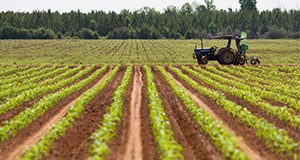
A new and innovative approach to Best Management Practices for fertilizer application known as 4R nutrient stewardship is available, to ensure the environmental, social, and economical sustainability of commercial crop production. This 3-page fact sheet focuses on the basic concepts of the 4R nutrient stewardship principles for commercial crop production. Written by Guodong Liu, Kelly Morgan, Yuncong Li, Lincoln Zotarelli, James DeValerio, and Qingren Wang, and published by the UF Department of Horticultural Sciences, July 2015.
http://edis.ifas.ufl.edu/hs1264
Snap Bean Soil Fertility Program in Miami-Dade County
In terms of acreage, snap beans are the most commonly grown vegetable in Miami-Dade County. This 2-page facts sheet outlines the impact of fertilizer use and local weather and soil on snap bean production in this region. Written by Monica Ozores-Hampton, Qiang Zhu, and Yuncong Li, and published by the UF Department of Horticultural Sciences, May 2015. http://edis.ifas.ufl.edu/hs1261
Pepper Production in Miami-Dade County, Florida
 Pepper is an important vegetable crop in Miami-Dade County. Unlike other vegetable crops, peppers are relatively more adaptable to the environment, especially the heat, and are relatively easier to grow. But to be successful, careful attention must be paid to maintain healthy plants and high productivity with efficient management of soil and water for the particular needs of each variety or cultivar. This 7-page fact sheet provides general information and guidelines for pepper growers in Miami-Dade County, including major pepper varieties, and their horticultural traits, and fundamental soil and water management requirements. Written by Qingren Wang, Shouan Zhang, Yuncong Li, Dakshina Seal, Waldemar Klassen, and Teresa Olczyk, and published by the UF Department of Horticultural Sciences, February 2015.
Pepper is an important vegetable crop in Miami-Dade County. Unlike other vegetable crops, peppers are relatively more adaptable to the environment, especially the heat, and are relatively easier to grow. But to be successful, careful attention must be paid to maintain healthy plants and high productivity with efficient management of soil and water for the particular needs of each variety or cultivar. This 7-page fact sheet provides general information and guidelines for pepper growers in Miami-Dade County, including major pepper varieties, and their horticultural traits, and fundamental soil and water management requirements. Written by Qingren Wang, Shouan Zhang, Yuncong Li, Dakshina Seal, Waldemar Klassen, and Teresa Olczyk, and published by the UF Department of Horticultural Sciences, February 2015.
http://edis.ifas.ufl.edu/tr010
Controlled-Release and Slow-Release Fertilizers as Nutrient Management Tools
 There are many fertilizer sources available for commercial crop production. The characteristics of each fertilizer type determine whether its use poses an advantage or a disadvantage to a farmer. This 6-page fact sheet focuses on how to select the right fertilizer to enhance profitability and satisfy best management practices (BMPs). Written by Guodong Liu, Lincoln Zotarelli, Yuncong Li, David Dinkins, Qingren Wang, and Monica Ozores-Hampton, and published by the UF Department of Horticultural Sciences, October 2014. (UF/IFAS Photo by Thomas Wright)
There are many fertilizer sources available for commercial crop production. The characteristics of each fertilizer type determine whether its use poses an advantage or a disadvantage to a farmer. This 6-page fact sheet focuses on how to select the right fertilizer to enhance profitability and satisfy best management practices (BMPs). Written by Guodong Liu, Lincoln Zotarelli, Yuncong Li, David Dinkins, Qingren Wang, and Monica Ozores-Hampton, and published by the UF Department of Horticultural Sciences, October 2014. (UF/IFAS Photo by Thomas Wright)
http://edis.ifas.ufl.edu/hs1255
Bush Snapbean Production in Miami-Dade County, Florida
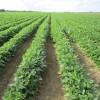 Miami-Dade County is the primary production region for fresh-market bush snapbeans with 57% or 18,696 acres of the Florida bean acreage. Production costs vary from $16.53 to $21.87 per 30 lb. bushel or $4,046 to $4,711 per acre. Acceptable yields range from 185 to over 300 bushels per acre. Snapbeans produced in Miami-Dade County are sold nationwide for the fresh market starting just before Thanksgiving and continuing through the winter and spring months. This 9-page fact sheet was written by S. Zhang, D. Seal, M. Ozores-Hampton, M. Lamberts, Y. Li, W. Klassen, and T. Olczyk, specifically for growers in Miami-Dade County as a supplement to The Vegetable Production Handbook for Florida (SP170). Published by the UF Department of Horticultural Sciences, July 2014.
Miami-Dade County is the primary production region for fresh-market bush snapbeans with 57% or 18,696 acres of the Florida bean acreage. Production costs vary from $16.53 to $21.87 per 30 lb. bushel or $4,046 to $4,711 per acre. Acceptable yields range from 185 to over 300 bushels per acre. Snapbeans produced in Miami-Dade County are sold nationwide for the fresh market starting just before Thanksgiving and continuing through the winter and spring months. This 9-page fact sheet was written by S. Zhang, D. Seal, M. Ozores-Hampton, M. Lamberts, Y. Li, W. Klassen, and T. Olczyk, specifically for growers in Miami-Dade County as a supplement to The Vegetable Production Handbook for Florida (SP170). Published by the UF Department of Horticultural Sciences, July 2014.
http://edis.ifas.ufl.edu/tr005
Conversions of parts per million on soil test reports to pounds per acre
 Soil testing and the resulting fertilization recommendations are critical for appropriate nutrient management in commercial vegetable production, but growers and soil experts sometimes speak different languages. This 8-page fact sheet provides a simple conversion method for crop consultants, crop advisors, growers, students, and researchers who are interested in nutrient and water management of crop production. Written by Guodong Liu, Yuncong Li, and Aparna Gazula, and published by the UF Department of Horticultural Sciences, August 2013.
Soil testing and the resulting fertilization recommendations are critical for appropriate nutrient management in commercial vegetable production, but growers and soil experts sometimes speak different languages. This 8-page fact sheet provides a simple conversion method for crop consultants, crop advisors, growers, students, and researchers who are interested in nutrient and water management of crop production. Written by Guodong Liu, Yuncong Li, and Aparna Gazula, and published by the UF Department of Horticultural Sciences, August 2013.
http://edis.ifas.ufl.edu/hs1229
Using Tensiometers for Vegetable Irrigation Scheduling in Miami-Dade County (ABE326/TR015)
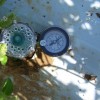 A tensiometer is a simple and relatively inexpensive tool that can be used to schedule irrigation in Miami-Dade County vegetable crops. Tensiometers continuously measure soil water potential or tension. If the tension in the soil is high, plants have to use more energy to extract soil water. If tension in the soil is low, then plants have lower energy requirements to extract soil water. This 6-page fact sheet was written by Kati W. Migliaccio, Teresa Olczyk, Yuncong Li, Rafael Muñoz-Carpena, and Tina Dispenza, and published by the UF Department of Agricultural and Biological Engineering, December 2012.
A tensiometer is a simple and relatively inexpensive tool that can be used to schedule irrigation in Miami-Dade County vegetable crops. Tensiometers continuously measure soil water potential or tension. If the tension in the soil is high, plants have to use more energy to extract soil water. If tension in the soil is low, then plants have lower energy requirements to extract soil water. This 6-page fact sheet was written by Kati W. Migliaccio, Teresa Olczyk, Yuncong Li, Rafael Muñoz-Carpena, and Tina Dispenza, and published by the UF Department of Agricultural and Biological Engineering, December 2012.
http://edis.ifas.ufl.edu/tr015
Understanding and Applying Chelated Fertilizers Effectively Based on Soil pH (HS1208)
 Plant nutrients are one of the environmental factors essential for crop growth and development. Nutrient management is crucial for optimal productivity in commercial crop production. Those nutrients in concentrations of ≤ 100 parts per million (ppm) in plant tissues are described as micronutrients and include iron (Fe), zinc (Zn), manganese (Mn), copper (Cu), boron (B), chlorine (Cl), molybdenum (Mo), and nickel (Ni). Micronutrients such as Fe, Mn, Zn, and Cu are easily oxidized or precipitated in soil, and their utilization is, therefore, not very efficient. Chelated fertilizers have been developed to increase micronutrient utilization efficiency. This 5-page fact sheet provides an overview of chelated fertilizers and considerations for their use to county Extension faculty, growers, and students who are interested in commercial crop production. Written by Guodong Liu, Edward Hanlon, and Yuncong Li, and published by the UF Department of Horticultural Sciences, November 2012.
Plant nutrients are one of the environmental factors essential for crop growth and development. Nutrient management is crucial for optimal productivity in commercial crop production. Those nutrients in concentrations of ≤ 100 parts per million (ppm) in plant tissues are described as micronutrients and include iron (Fe), zinc (Zn), manganese (Mn), copper (Cu), boron (B), chlorine (Cl), molybdenum (Mo), and nickel (Ni). Micronutrients such as Fe, Mn, Zn, and Cu are easily oxidized or precipitated in soil, and their utilization is, therefore, not very efficient. Chelated fertilizers have been developed to increase micronutrient utilization efficiency. This 5-page fact sheet provides an overview of chelated fertilizers and considerations for their use to county Extension faculty, growers, and students who are interested in commercial crop production. Written by Guodong Liu, Edward Hanlon, and Yuncong Li, and published by the UF Department of Horticultural Sciences, November 2012.
http://edis.ifas.ufl.edu/hs1208
Are Phosphorous and Phosphoric Acids Equal Phosphorous Sources for Plant Growth? (HS1010/HS254)
 Phosphorus (P) is one of the 17 elements essential for plant growth and development, and is also a key component in some agrochemicals, such as phosphorous acid. Thus, there are two types of P closely associated with crop production. The similarity of terms such as phosphoric acid and phosphorous acid may create some confusion as to the actual content and efficacy of these products. This 7-page fact sheet explains what phosphorous acid is and examines both its fungicidal activity and nutrient value. Written by Asha M. Brunings, Guodong Liu, Eric H. Simonne, Shouan Zhang, Yuncong Li, and Lawrence E. Datnoff, and published by the UF Department of Horticultural Sciences, March 2012.
Phosphorus (P) is one of the 17 elements essential for plant growth and development, and is also a key component in some agrochemicals, such as phosphorous acid. Thus, there are two types of P closely associated with crop production. The similarity of terms such as phosphoric acid and phosphorous acid may create some confusion as to the actual content and efficacy of these products. This 7-page fact sheet explains what phosphorous acid is and examines both its fungicidal activity and nutrient value. Written by Asha M. Brunings, Guodong Liu, Eric H. Simonne, Shouan Zhang, Yuncong Li, and Lawrence E. Datnoff, and published by the UF Department of Horticultural Sciences, March 2012.
http://edis.ifas.ufl.edu/hs254
Irrigation Scheduling for Tropical Fruit Groves in South Florida (TR001)
Irrigation scheduling can be accomplished using different tools, each with its benefits and weaknesses. It is critical to use each tool as it is intended to ensure tropical fruit trees have the irrigation water they need. This 6-page fact sheet was written by K. W. Migliaccio and Y. C. Li, and published by the UF Department of Agricultural and Biological Engineering, February 2012.
http://edis.ifas.ufl.edu/tr001
Controlled-Release Fertilizers for Potato Production in Florida (HS941/HS187)
 The recent emphasis on the development of vegetable production best management practices has prompted a re-examination of fertilization practices in Florida potato production in the St. Johns River watershed. The numbers provided in this 5-page fact sheet serve as a starting point for discussion about the value of using controlled-release fertilizers, which can be a win-win-win opportunity for producers, manufacturers, and regulatory agencies by helping all meet their production, business, and environmental goals. Written by Guodong Liu, Eric H. Simonne, Yuncong Li, Chad M. Hutchinson, Mark Warren, and Steven Lands, and published by the UF Department of Horticultural Sciences, October 2011. (UF/IFAS Photo by Tyler Jones)
The recent emphasis on the development of vegetable production best management practices has prompted a re-examination of fertilization practices in Florida potato production in the St. Johns River watershed. The numbers provided in this 5-page fact sheet serve as a starting point for discussion about the value of using controlled-release fertilizers, which can be a win-win-win opportunity for producers, manufacturers, and regulatory agencies by helping all meet their production, business, and environmental goals. Written by Guodong Liu, Eric H. Simonne, Yuncong Li, Chad M. Hutchinson, Mark Warren, and Steven Lands, and published by the UF Department of Horticultural Sciences, October 2011. (UF/IFAS Photo by Tyler Jones)
http://edis.ifas.ufl.edu/hs187
Nickel Nutrition in Plants (HS1191)
This 5-page fact sheet introduces agricultural and horticultural producers to the role and function of the newest identified essential plant nutrient, nickel (Ni). Written by Guodong Liu, E. H. Simonne, and Yuncong Li, and published by the UF Department of Horticultural Sciences, June 2011.
http://edis.ifas.ufl.edu/hs1191
Evolution of water quality regulations in the United States and Florida (AE431)
Water is essential to sustain life. Not only do we all need a certain quantity of water each day, but the quality of the available water is also critical. Water quality protection in the United States evolved from initially ensuring navigability of waterways to protecting our natural ecosystems. This 5-page fact sheet provides a background for understanding water quality and how it is evaluated and regulated in the U.S. with particular focus on the state of Florida. Written by Kati W. Migliaccio, Yuncong Li, and Thomas A. Obreza. Published by the UF Department of Agricultural and Biological Engineering, January 2011.
http://edis.ifas.ufl.edu/ae431
ABE368/AE396 South Florida Tropical Fruit Grower Perspectives: Water Conservation Management Practices
Revised! ABE368, a 6-page fact sheet by Kati W. Migliaccio, Jonathan H. Crane, Edward Evans, Bruce Schaffer, Yuncong Li, and Rafael Muñoz-Carpena, presents results of fruit grower responses from a survey designed to assess changing views of agricultural producers in Miami-Dade county from 2006 to 2009 regarding water quantity and quality management practices — methods, demographics, water quality and quantity opinions concerning lifestyle, agriculture, and best management practices (BMPs). Includes references. Published by the UF Department of Agricultural and Biological Engineering, November 2009.
http://edis.ifas.ufl.edu/AE396
SL289/SS502 Wetland Delineation: An Overview of Regulations and Methods
SL289, a 4-page illustrated fact sheet by Daniel L. Irick, Yuncong Li, and Alan L. Wright, describe the regulatory nature of wetland delineation and classification for landowners, wetland and soil scientists, and the
general public. Includes references. Published by the UF Department of Soil and Water Science, May 2009.
http://edis.ifas.ufl.edu/SS502
SL306/TR003 Sunn Hemp – A Cover Crop in Florida
Revised! SL-306 (formerly SS-AGR-96), a 4-page illustrated fact sheet by Yuncong Li, Qingren Wang, Waldemar Klassen, Edward A. Hanlon, Jr., describes this green manure crop that has been grown for centuries in Southeast Asia — origin and distribution, description, uses, production and harvest, and seed production. Includes references. Published by the UF Department of Soil and Water Sciences, August 2009.
http://edis.ifas.ufl.edu/TR003
HS1156 Review of Nutrient Management Systems for Florida Vegetable Producers
HS1156, a 17-page white paper from the UF/IFAS Vegetable Fertilizer Task Force, identifies differences between actual fertilization practices and UF/IFAS fertilizer recommendations, especially for vegetables grown with subsurface (Central and South Florida) and overhead (Miami-Dade County) irrigation. The recommendations of the VFTF aim at bridging the gaps between science-based results and the diversity in production systems found in the Florida vegetable industry. Includes references. Published by the UF Department of Horticultural Sciences, April 2009.
http://edis.ifas.ufl.edu/HS1156
TR001 Irrigation Scheduling for Tropical Fruit Groves in South Florida
TR001, a 6-page illustrated fact sheet by Kati W. Migliaccio and Yuncong Li, describes why irrigation is needed in south Florida, and the advantages and disadvantages of various tools available for determining an optimum irrigation schedule. Includes references. Published by the UF Department of Agricultural and Biological Engineering, January 2009.
http://edis.ifas.ufl.edu/TR001
